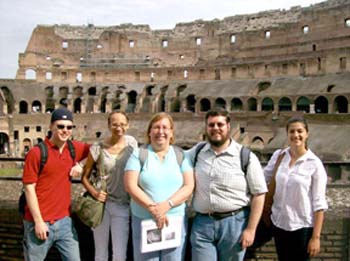Summer Program in the Ancient World Yields Student Insights

In summer 2010 the Classical Studies Department sponsored an intensive three-week program in Ancient Roman Studies, led by Professor Barbette Spaeth and focused on Rome and Pompeii. Students visited archaeological sites, and studied monuments and works of art in their original settings.
As part of the program, participating students wrote journal essays about their experiences and what they learned. Below we present some excepts from their insights.
Brent Bickings '11
I am an Honors candidate researching third century C.E. interaction between Jews and Gentiles in the Roman Empire. I am focusing on archaeological and architectural evidence, particularly in the synagogue. . . . I could not have performed my research adequately without visiting the actual sites. While in Ostia, we did just that. What an adventure that was! The ruins are well off the beaten path and are difficult to find. We had to stomp our way through waist-high weeds that kicked up pollen and activated the allergies, and we had to be constantly mindful of holes that were covered by the grass. When we finally reached the site, I was able to present that part of my research to the group, bouncing ideas off of them. John Kelly raised a point that I hadn’t even considered (nor had any of the sources that I had read) concerning the kitchen and rooms attached to the sanctuary: He asked whether those could have been the residence of the synagogue official. I was able to explore each room of the compound and literally photographed every inch of the site for my research paper.
John Kelly '11
Donning hardhats and lanterns, we explored the depths of the Jewish catacombs, where our stay was limited to less than thirty minutes because of radon and carbon monoxide levels. Inside the dark tunnels, ancient bones still lay in burial niches along the walls. Our journey through this network of subterranean tunnels made me feel as if we were archaeologists discovering them for the first time.
Professor Spaeth got us permission to see what archaeologists have termed “the burrito.” Recently found in Gabii by a team that includes former William & Mary professor Jeff Becker, “the burrito” is a nearly unparalleled burial style in which a body is wrapped in a lead casing. The archaeologists plan to examine the inside of the burrito, and there is a chance the body may contain remnants of clothing. I found it absolutely fascinating to see a recent and exciting archaeological discovery that has the potential to teach us new information about the Roman world.
Experiencing and immersing myself in the world of ancient Rome has allowed me to learn more than I ever could from pictures in textbooks or online. If a picture’s worth a thousand words, then exploring what’s in the picture firsthand must be worth millions.
Irene Morrison-Moncure '11
I spent my first week in Rome getting used to the fact that nothing is the size I had imagined and everything is much closer together.
One of our favorite spots was the commercial town of Ostia because once past the main gate there were very few restraints to hands-on learning. Not only could you wander through the ancient city streets, but we were able to listen to a report on Mithras in an actual mithraeum, and for another report we trekked through waist-high grass o to the synagogue on the outskirts of town.
Underground in the Church of Santa Maria in Comsedin we saw the Ara Maxima, which women were not allowed around because women were not part of the cult. Not only did I feel special as a woman standing right on top of the altar, but I got a good feel how large the altar really was. The church was built on top of the altar, so the huge flagstones in the crypt were actually just the small exposed portion of the much larger altar. Having access to such sites with special permessi made many of these out-of-the-way visits a possibility.
Lena Shrestha '10
I had become so accustomed to viewing wall paintings as prints in textbooks or slideshows that I had almost forgotten that painters actually worked on-site to decorate frescoes in detail. The museums and sites with wall paintings available to be viewed up-close reminded me of each brushstroke involved; we even learned about the sources of various pigments used for paint and saw the various tools and pellets of pigment. The experience of seeing these monuments closely was highlighted by the opportunity, through the program, to obtain permessi, or permissions from Italy to gain access to closed excavation sites. The ability to get a more intimate perspective of the objects we were studying was the chance of a lifetime!
The ideas that I’ve been taking note of during this trip have surprised me in that I had never considered Rome as such a fluid entity throughout time. Changes in the way I think about the lives of the Romans, as well as the motives behind their building projects, I think will certainly affect my future scholarship on this topic. I think that experiencing Rome in the first-person is an incomparable way to gain a unique perspective on the civilization.
 Skip to main content
Skip to main content
